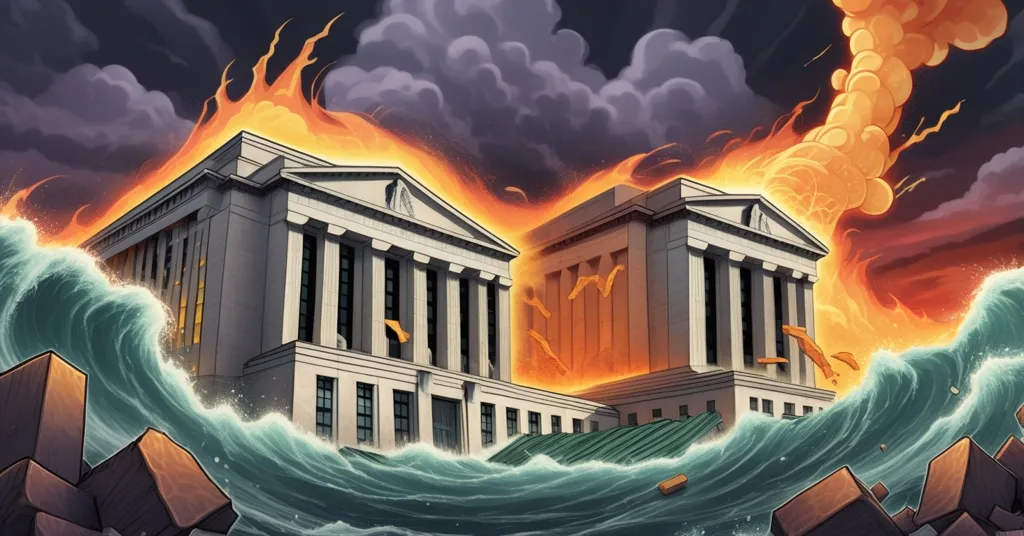Fed Governor Warns Stablecoins May Cut U.S. Rates as Bitcoin Crashes 20%

Fed Governor Warns: Stablecoins Could Slash U.S. Interest Rates Amid Brutal Bitcoin Crash
Federal Reserve Governor Steve Miran dropped a bombshell at a recent gathering of economists in New York, cautioning that the skyrocketing demand for U.S. dollar-pegged stablecoins could drag down the U.S. neutral interest rate by as much as 0.4 percentage points. This warning lands as the cryptocurrency market bleeds out, with a savage 20% plunge wiping out yearly gains and leaving Bitcoin dangling below $100,000. It’s a collision of traditional finance and digital disruption that’s impossible to ignore.
- Stablecoin Shockwave: Surging demand for dollar-pegged stablecoins may lower the U.S. neutral interest rate by boosting loanable funds.
- Policy Pivot: Miran insists the Fed must cut rates to avoid choking economic growth.
- Market Meltdown: A 20% crypto crash, fueled by $19 billion in liquidations, hammers Bitcoin and altcoins alike.
Let’s break down Miran’s alert with the gloves off. Stablecoins, for those new to the game, are cryptocurrencies engineered to hold a steady value by tying themselves to fiat currencies like the U.S. dollar. Unlike the rollercoaster rides of Bitcoin or Ethereum, stablecoins like Tether (USDT) and USDC act as digital cash—used for trading, cross-border payments, or parking funds during market storms. Their appeal has exploded globally, especially in regions hungry for dollar access, which drives massive demand for U.S. Treasury bills and other liquid assets that back these tokens to maintain their 1:1 peg. Miran’s point is blunt: this isn’t just crypto nerd territory anymore; it’s a seismic shift that’s messing with the very foundation of monetary policy.
Stablecoins: The Fed’s New Headache
At the heart of Miran’s argument is the neutral interest rate, a kind of “cruise control” benchmark for the economy. It’s the theoretical sweet spot where monetary policy neither revs up inflation nor slams the brakes on growth. According to Miran, the flood of capital into stablecoins—often parked in U.S. Treasuries by issuers like Tether, which holds billions in these safe assets to back USDT—effectively pumps up the supply of loanable funds. Think of loanable funds as the pool of money out there for businesses and individuals to borrow. More money to lend means less pressure on interest rates, pushing the neutral rate down by an estimated 0.4 percentage points even under cautious growth projections for stablecoins. As Miran put it with no sugarcoating, as reported on Cryptopolitan:
“Even relatively conservative estimates of stablecoin growth imply an increase in the net supply of loanable funds in the economy that pushes down the neutral rate.”
This isn’t some ivory tower theory. If the neutral rate dips because of stablecoin mania, the Federal Reserve can’t just sit on its hands. Miran argues they’ve got to slash policy rates to match, or risk tightening the screws on the economy unintentionally, which could choke growth when it’s already wobbly. He didn’t hold back on the stakes:
“If neutral is lower, policy rates should also be lower than they would otherwise be to support a healthy economy.”
What’s wilder is how Miran framed stablecoins as a “multitrillion-dollar elephant in the room” for central bankers. With market caps for tokens like Tether already surpassing $120 billion as of late 2023 (per CoinGecko data), and USDC not far behind, they’re no longer a sideshow. When international investors stash their wealth in stablecoins backed by U.S. assets, they’re not just playing crypto roulette—they’re jacking with the cost of borrowing for everyone from Wall Street to Main Street. Yet, let’s play devil’s advocate for a second: some economists might scoff that stablecoins are still a drop in the bucket compared to the global financial ocean. Is their impact really enough to rewrite the Fed’s playbook, or is this overhyped? We’re leaning toward Miran’s take—disruption doesn’t wait for permission—but the jury’s still out.
Adding spice to the mix is Miran’s background. As a Trump-appointed Fed Governor set to exit in January, his comments carry a whiff of the administration’s pro-crypto tilt. Trump’s push to make the U.S. a global crypto hub has hyped up the space, with institutional players and regulators starting to cozy up to digital assets earlier this year. Bitcoin ETFs got the green light, major banks dipped into blockchain, and stablecoins seemed like the perfect bridge between fiat and decentralized finance (DeFi). But while Miran’s spotlight on stablecoins signals long-term potential, the short-term reality of the crypto market is a straight-up horror show.
Crypto Crash: $19 Billion in Pain
As if on cue to remind us of crypto’s savage side, the market imploded with a 20% nosedive since hitting a peak of nearly $4.4 trillion on October 6. Bitcoin, the heavyweight champ we Bitcoin maximalists root for as the ultimate store of value, shed 9% in just one week—its worst drop since March. It’s now trading below $100,000 and, for the chart geeks out there, has slipped under its 200-day moving average, a trendline traders use to gauge long-term price direction. That’s a big red flag for momentum. Altcoins—those speculative wildcards like Ethereum, Solana (down a brutal 25% in a week), and countless others—got absolutely crushed even harder, proving once again that Bitcoin’s dominance isn’t just philosophical; it’s practical in a bear market.
What lit the fuse? A staggering $19 billion liquidation of leveraged positions. For the uninitiated, this means traders borrowed heaps of cash to amplify their bets on crypto prices, only to get obliterated when the market turned south. It’s like betting your house on a coin flip and watching it land on edge—pure carnage. Margin calls cascaded, forcing sales that tanked prices further. Data from CryptoQuant shows trader sentiment in the gutter, with no confidence in a quick rebound. This isn’t the first rodeo for crypto veterans, but for newcomers, it’s a baptism by fire. And let’s get real: those X posts screaming “Bitcoin to $1M by Christmas”? Utter delusional garbage. We’re not here to peddle pipe dreams; we’re here to call out the nonsense.
The irony stings. Earlier this year, the crypto space was buzzing with optimism. Regulatory nods, Wall Street buy-in, and Trump’s vocal advocacy had many of us thinking mainstream adoption was just around the corner. Bitcoin was “digital gold,” altcoins promised Lambos, and stablecoins were the steady hand guiding fiat into DeFi. But this crash is a gut check. For every leap toward legitimacy, there’s a trapdoor of speculative excess waiting to swallow the over-leveraged and the naive. Volatility isn’t just a feature of crypto—it’s the damn DNA.
Stablecoins: Saviors or Systemic Risks?
So, where do stablecoins fit in this mess? On one hand, they’re a beacon of relative calm in a sea of chaos, offering a less volatile store of value than Bitcoin or altcoins. Need to send money overseas fast without bank fees? Stablecoins. Want to trade without getting whipsawed by Bitcoin’s mood swings? Stablecoins. They’ve carved a niche Bitcoin wasn’t built for—fast, cheap transactions, often a lifeline for the unbanked in unstable economies. Tether’s been at it since 2014, and despite endless drama over reserve transparency (are those Treasuries really there? Audits are still a sore spot), its growth shows no sign of slowing.
Yet, their macroeconomic clout is a double-edged sword. If Miran’s right, stablecoins could force the Fed into uncharted territory—think rate cuts or even new crypto-specific regulations. That’s where skeptics raise an eyebrow. Could their rise invite a regulatory crackdown, turning a tool of decentralization into a leash for government control? Imagine central banks using stablecoin growth as an excuse to slap on digital dollar CBDCs (central bank digital currencies) with tracking baked in. It’s a nightmare for privacy hawks like us who champion freedom over fiat tyranny. On the flip side, stablecoins could accelerate financial inclusion, embodying the “effective accelerationism” (e/acc) we cheer for—disrupting dusty banking systems and bringing billions into a borderless economy. It’s a tightrope, and we’re watching every step.
Balancing Disruption and Reality
Miran’s warning isn’t just for Fed suits; it’s a wake-up call for everyone in the crypto trenches. Stablecoins might be redrawing the financial map, nudging central bankers to rethink centuries-old playbooks, but the market’s latest bloodbath proves the path to a decentralized future is paved with landmines. As Bitcoin maximalists, we see BTC as the bedrock of this revolution—a hedge against fiat debasement and a middle finger to centralized control. But we can’t pretend stablecoins and altcoins don’t have their place. Ethereum’s smart contracts and DeFi experiments push boundaries Bitcoin shouldn’t bother with, while stablecoins bridge the gap for practical use cases.
Still, amidst the wreckage of a $19 billion liquidation and a market that’s lost its swagger, it’s clear mass adoption isn’t a straight line. Stablecoins might nudge interest rates and legitimize crypto’s economic footprint, but they’re no magic fix. For every policymaker like Miran taking them seriously, there are scammers and hype-men ready to exploit the chaos. We’re all in on decentralization, privacy, and shattering the status quo, but let’s not drink the Kool-Aid blind. Crypto’s promise is real, but so are its pitfalls. Here’s what to chew on as we navigate this wild ride:
Key Questions and Takeaways on Stablecoins and Crypto Volatility
- How do stablecoins influence the U.S. neutral interest rate?
By fueling demand for U.S. dollar assets like Treasuries to back their peg, they swell the supply of loanable funds, potentially cutting the neutral rate by up to 0.4 percentage points, per Fed Governor Steve Miran’s analysis. - Why does the Federal Reserve need to tweak its policies for stablecoins?
Miran stresses that failing to lower policy rates alongside a dropping neutral rate could tighten economic conditions, risking a slowdown nobody wants. - What sparked the recent 20% cryptocurrency market crash?
A catastrophic $19 billion liquidation of leveraged bets sent Bitcoin below $100,000 and altcoins into a deeper spiral, gutting trader confidence overnight. - Can stablecoins shield investors from crypto market volatility?
They offer a stabler alternative to volatile assets like Bitcoin, but their growing sway over traditional finance could introduce fresh systemic risks beyond the crypto sphere. - Was the crypto industry’s earlier optimism built to last?
Regulatory wins and institutional backing sparked hope, but recurring crashes lay bare the speculative traps that still riddle the path to mainstream acceptance. - Might stablecoins trigger tougher government oversight?
Their macroeconomic ripples could push central banks toward stricter rules, clashing with crypto’s decentralization ethos, though smart regulation might also add credibility if done right.
The clash of stablecoin influence and crypto chaos is a microcosm of the broader battle for a decentralized tomorrow. We’re rooting for disruption—full throttle—but not without a clear-eyed view of the hurdles. Stablecoins could be the quiet game-changers that force the old guard to adapt, or they could open the door to control we’ve fought to escape. Bitcoin remains our north star, but the ecosystem’s diversity, from stablecoins to Ethereum’s innovations, fuels the revolution in ways BTC alone can’t. One thing’s for damn sure: in this space, the only constant is the unexpected. Keep your head on a swivel.



